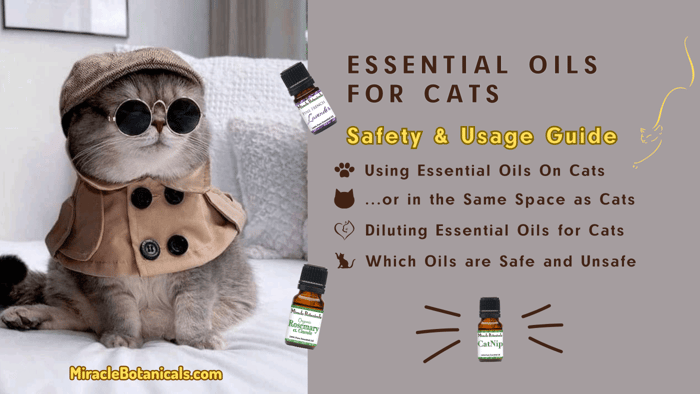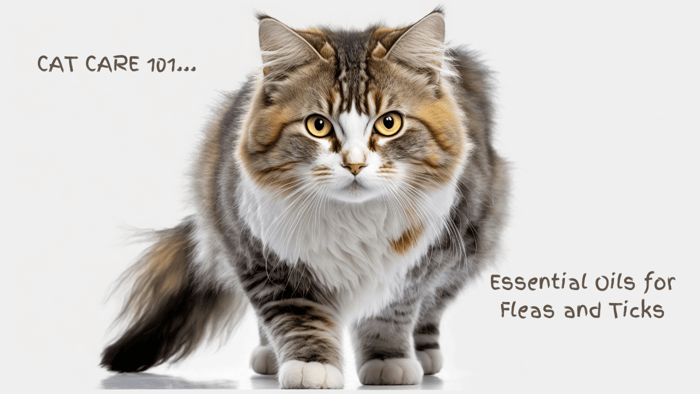Essential oils for cats, concentrated extracts from plants, have grown in popularity for their aromatic and therapeutic benefits. However, when it comes to our feline friends, what essential oils are safe for cats becomes a critical question, as these substances can be toxic due to cats' inability to metabolize certain toxins [3]. These risks are amplified by the fact that essential oils can be found not only in pure form but also in a variety of beauty and cleaning products, raising concerns over unintentional exposure [1].
The safety of essential oils around pets, particularly cats, dogs, and other small animals, is a subject of increasing importance. Cats are especially vulnerable to essential oils toxic to cats, suffering from symptoms like liver damage due to a lack of a crucial enzyme needed to break down these compounds [3] [5]. Understanding which essential oils are safe for cats and which are considered essential oils bad for cats is essential for pet owners aiming to use these products without causing harm [1] [4].
Table of Contents
What Are Essential Oils?
Essential oils, the essence of aromatherapy and numerous household products, are concentrated hydrophobic liquids filled with volatile aroma compounds from plants [1]. Their extraction methods vary widely, including:
- Distillation
- Expression
- Solvent extraction
- Sfumatura
- Absolute oil extraction
- Resin tapping
- Wax embedding
- Cold pressing [1]
These methods ensure the capture of the plant's essence in its purest form. Essential oils are not just limited to aromatherapy; they have a broader application spectrum:
- Perfumes and cosmetics: Adding natural fragrances.
- Soaps and air fresheners: Enhancing with natural scents.
- Food and drink flavoring: Offering natural taste enhancements.
- Incense and household cleaning products: Providing natural aromas [1].
However, the use of essential oils for cats must be approached with caution. Improper handling or usage can lead to adverse effects such as allergic reactions, skin irritation, and even poisoning if ingested or absorbed through the skin [1]. This underscores the importance of understanding the nature and safe use of essential oils, especially in environments shared with pets like cats, who may be more susceptible to their toxic effects [1].
The Dangers of Essential Oils to Cats
Understanding the risks essential oils pose to cats is crucial for pet owners. Cats are particularly sensitive to certain essential oils due to their unique physiology. Here are the key points to consider:
- High-Risk Essential Oils: Some essential oils are more toxic to cats and should not be used directly on cats or diffused in closed spaces where cats don't have a way to exit the space. These include:
- Routes of Exposure: Cats can come into contact with essential oils through various means, each presenting its own set of risks:
- Symptoms of Toxicity: Recognizing the signs of essential oil poisoning is vital for timely intervention. Symptoms include:
Pet owners should exercise caution, avoiding the use of high-risk essential oils on or around cats and watching for signs of toxicity.
Safe Essential Oils for Cats
While many essential oils pose risks to our feline companions, a select few are considered generally safe when used appropriately and with care. Here's a closer look at those:
- Generally Safe Essential Oils:
- Lavender, Frankincense, and Chamomile: Known for their calming properties, these oils are safe to diffuse around cats in moderation [7].
Note on Lavender: pure lavender oil, when diffused in moderation, is often considered one of the safer options for pets. Different cats react differently that's why it's also listed in the danger zone, so just be aware.
- Cedarwood: Recognized for its pest repellent qualities, cedarwood oil is safe for cats when diluted properly [8].
- Lemongrass: While not for ingestion or direct skin application, lemongrass oil can be safe in low concentrations [8].
- Rosemary: Useful as a flea repellent, rosemary can be safely used by boiling a twig and diluting the solution [8].
- Catnip: a safe and non-toxic herb from the mint family, stimulates natural play and reduces stress in cats, with effects varying among individuals and best used in moderation.
- Additional Safe Options: Copaiba, Turmeric, Copaiba, Petitgrain and Helichrysum also make the list, emphasizing the importance of minimal use and caution.
- Lavender, Frankincense, and Chamomile: Known for their calming properties, these oils are safe to diffuse around cats in moderation [7].
- Topical and Diffusion Guidelines:
- Topical Preparations: Products with 1% essential oil concentrations are generally safe for occasional use around cats.
- Diffusion: Most essential oils, when used sensibly, can be safe for low-level, intermittent diffusion in pet grooming products.
This careful selection and usage ensure the well-being of our pets while allowing us to enjoy the benefits of essential oils.
View Related Article: Cat Care 101 - Essential Oils for Fleas and Ticks
Practical Tips for Using Essential Oils Around Cats
When incorporating essential oils for cats in your household, it's crucial to prioritize their safety and well-being. Here are practical tips for using essential oils around cats:
- Consultation and Dilution:
- If you're not sure, we recommend consulting with a veterinarian or aromatherapist before introducing essential oils into your home environment [7].
- Use essential oils in diluted form, mixing them with a carrier oil to reduce potency.
- For diffusion, place diffusers on high surfaces out of cats' reach and use them sparingly.
- Storage and Handling:
- Store essential oils and products containing them in secure locations inaccessible to cats [1].
- Wash hands thoroughly after handling essential oils to prevent accidental transfer to your pet [1].
- Check labels on pet products for essential oils and opt for pet-specific items designed with safety in mind.
- Minimizing Exposure:
- Avoid using diffusers in the same room where cats groom or spend a lot of time [17].
- Keep essential oils, diffusers, and warmers well out of reach to prevent curious investigations [17].
- Provide an easy exit for cats from areas where essential oils are being diffused, in case the aroma becomes overwhelming [17].
Recognizing Signs of Essential Oil Toxicity in Cats
Recognizing the signs of essential oil toxicity in cats is vital for their health and safety. Here are the symptoms and immediate actions to take:
Symptoms of Essential Oil Toxicity in Cats:
- General Signs: Vomiting, lethargy, depression, loss of appetite, diarrhea, and seizures [9].
- Neurological Signs: Muscle tremors, unsteadiness or wobbliness, difficulty walking or uncoordinated gait, and collapsing or seizures [1] [12].
- Respiratory Signs: Difficulty breathing, coughing, sneezing, and breathing with an open mouth [1] [12].
- Dermatological Signs: Fragrance or scent on hair coat, skin, or breath, redness or burns on the lips, gums, tongue, or skin [12].
- Other Signs: Blood in the stool/urine, inability to urinate, bruising, nosebleeds, salivation, weakness, irregular heartbeat, low body temperature, and liver failure [9].
Immediate Actions if Poisoning is Suspected:
- Contact a Vet: Provide information about the oil involved, amount ingested, cat's weight, and age [1].
- Do Not Induce Vomiting: Avoid giving activated charcoal or inducing vomiting [12].
- Wash Off the Product: If any product is on the skin or fur, wash it off using a liquid dishwashing detergent [12].
- Prepare for the Vet Visit: Put the product packaging in a sealed container and take it with you to the veterinary clinic [12].
Treatment Options:
- Veterinary Care: Treatment may include blood work, intravenous fluids, a soft diet or feeding tube, anti-vomiting medication, stomach protectants, pain medication, antibiotics, and medication to protect the liver [12].
- Prognosis: With early intervention and supportive treatment, most cats can survive [12].
Conclusion
Through this comprehensive exploration, we have navigated the intricate relationship between essential oils and cats, highlighting the importance of understanding which oils are safe and which pose potential risks. It's clear that while essential oils offer numerous benefits to humans, their use around cats requires careful selection, dilution, and moderation to prevent harm. Pet owners have a responsibility to familiarize themselves with the high-risk oils, recognize signs of toxicity, and prioritize the safety of their feline companions by adhering to guidelines for safe usage.
In doing so, the well-being of our pets doesn't have to be compromised for the enjoyment and benefits of essential oils for cats in our lives. When employed thoughtfully, essential oils can coexist in harmony with cats, enhancing our living spaces while keeping our cherished pets safe and healthy. For those looking to buy essential oils that bring aromatic bliss to their homes without jeopardizing the health of their pets, consider browsing through a selection of cat-safe options here. Embrace the benefits of essential oils for cats with the peace of mind that you are doing so in a way that is safe for all members of your family—furry ones included.
FAQs
Is It Safe to Use Essential Oils Around Cats?
It is generally advised to refrain from diffusing essential oils in the presence of both dogs and cats. The risk arises not only from the inhalation of potentially harmful essential oils but also from the possibility of oil microdroplets settling on your pet's fur. Such exposure can lead to the oils being absorbed through the skin or ingested when the pet grooms itself.
Can Essential Oils Be Used for Cleaning in a Home with Cats?
When cleaning in a household with cats, it is important to avoid using undiluted essential oils. Cats have a habit of rubbing against surfaces, which could result in the oils transferring to their fur. If essential oils are used, they should be significantly diluted to reduce the risk of exposure to your cat.
What Does the ASPCA Say About the Safety of Essential Oils for Cats?
According to the ASPCA, essential oils are among the top substances that cause tremors in cats due to toxicity. While eucalyptus oil has been mentioned in social media posts, it is actually tea tree oil—which is sometimes applied to treat skin conditions in pets—that is more frequently associated with essential oil poisoning in cats.
How Soon Can Cats Show Reactions to Essential Oils?
The onset of clinical symptoms in cats exposed to essential oils can range from a few minutes to two hours. This timeframe is influenced by various factors, including the specific type of oil, the way it was exposed to the cat, its concentration, and the amount to which the animal was exposed.
References
[1] - https://www.webmd.com/pets/cats/risks-of-essential-oils-for-cats
[3] - https://www.petpoisonhelpline.com/blog/essential-oils-cats/
[4] - https://www.hillspet.com/cat-care/routine-care/essential-oils-for-cats
[5] - https://tisserandinstitute.org/cats-essential-oil-safety/
[6] - https://vcahospitals.com/know-your-pet/essential-oil-poisoning
[7] - https://www.quora.com/What-essential-oils-can-you-diffuse-safely-with-a-pet-cat-in-the-house-Are-any-oils-harmful-to-cats
[8] - https://avodermnatural.com/blog/essential-oils-cats-safe-list/
[9] - https://www.24petwatch.com/blog/are-essential-oils-safe-for-dogs-and-cats
[10] - https://www.cabbagetownpetclinic.com/blog/february-2020/how-do-essential-oils-affect-your-pet
[12] - https://vcahospitals.com/know-your-pet/essential-oil-and-liquid-potpourri-poisoning-in-cats
[13] - https://www.today.com/pets/essential-oils-danger-cats-warning-signs-look-t121300
[14] - https://happytailservet.com/blog/10-essential-oils-that-are-dangerous-to-your-cat/
[15] - https://www.quora.com/Are-essential-oil-diffusers-bad-for-cats
[16] - https://www.cats.org.uk/cats-blog/cats-and-essential-oils
[17] - https://www.dailypaws.com/cats-kittens/health-care/cat-poisoning-toxins/essential-oils-safe-for-cats
[18] - https://www.quora.com/What-essential-oils-are-safe-to-use-around-my-cat-short-haired-tabby-and-dog-great-Pyrenees-mix-in-a-diffuser






